Advertisement
Faster recovery with less pain, muscle damage
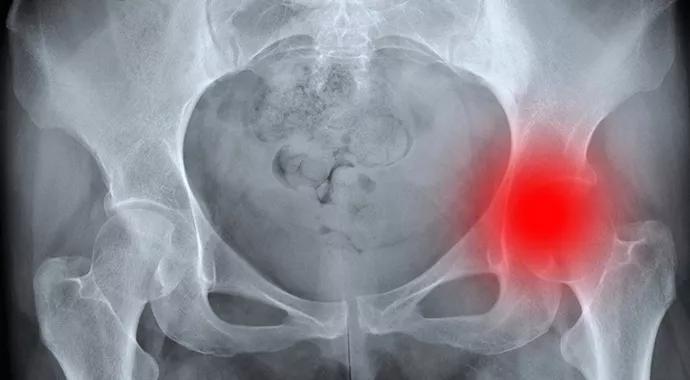
By Pratik P. Desai, MD, MS, and Carlos Higuera-Rueda, MD
Advertisement
Cleveland Clinic is a non-profit academic medical center. Advertising on our site helps support our mission. We do not endorse non-Cleveland Clinic products or services. Policy
Total hip arthroplasty is considered one of the most successful procedures of our modern surgical era. It improves quality of life, has an excellent success rate, relieves pain and restores mobility. We have found that using an anterior approach to total hip arthroplasty minimizes tissue damage and pain, and leads to a quicker recovery. The majority of hip arthroplasty procedures have used a posterior approach. The direct anterior approach to hip arthroplasty, first described in 1917, was not used extensively until recently due to technical concerns and the experience required.
Minimally invasive surgery was introduced to orthopaedics in the 1970s in the form of arthroscopy and later employed in open surgical procedures. Interest in minimally invasive approaches to total hip arthroplasty has resurfaced in recent years, with increased attention to the anterior approach. Perhaps more important than the implied shorter incision length is reduced damage to muscle and tissues within the operative field. In theory, less muscle damage leads to less pain and a quicker recovery from surgery. This theory is corroborated in the outcomes table.
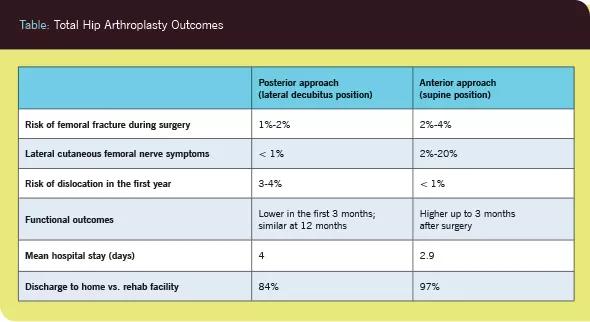
Using internervous or intermuscular planes is one way to decrease tissue damage, and the anterior approach to total hip arthroplasty follows this principle. The posterior approach can be minimally invasive in terms of a smaller incision and reduced exposure, but it does not use an internervous or intermuscular plane. In 2011, Bergin et al. compared the results of the minimally invasive anterior approach and the posterior approach to total hip arthroplasty. In particular, they evaluated the rise of muscle damage markers and inflammatory markers. Levels of serum creatine kinase (an indicator of muscle damage) were 5.5 times lower than markers of inflammation (CRP, IL-6, IL-1, TNF-alpha) in the anterior approach group compared to the posterior approach group.
Advertisement
Most traditional approaches to total hip arthroplasty employ the widely used lateral decubitus position with great success. However, this position makes access to the extremities ‒ and therefore intravenous access ‒ more challenging for anesthesia personnel. In addition, airway access becomes more difficult. This poses challenges for pulmonary hygiene during the procedure and for conversion from spinal to general anesthesia, if needed. Anterior total hip arthroplasty is performed in the more traditional supine position. This allows for easier patient suctioning/pulmonary hygiene and easier intravenous access. In addition, accurately assessing leg lengths is easier in the supine position.
Anterior total hip arthroplasty is not appropriate for every patient, especially at the beginning of a surgeon’s learning curve. To prevent complications, the surgeon must select patients for the procedure carefully and must have ample experience with this exposure. The anterior approach increases the risk of injury to the lateral femoral cutaneous nerve. The incidence of meralgia paresthetica has been 17 percent in some studies. In addition, femoral exposure can prove difficult; several series have demonstrated an approximately 2 percent risk of iatrogenic femoral fractures. Careful examination of physical characteristics is key, as a large pannus in an obese patient may predispose to wound breakdown, hematoma or infection. To avoid compromising the lateral femoral cutaneous nerve, we prefer a modified version of the anterior approach that uses a more lateral muscle interval, between the tensor fascia lata and the gluteus medius. This interval may improve hip joint exposure and can be extended should complications such as femur fractures occur.
Advertisement
Many studies have documented a faster recovery with less pain after anterior total hip replacement. A 2013 study retrospectively comparing the anterior and posterior approaches found that mean hospital stay (2.9 vs. 4 days) and days to patient mobilization (2.4 vs. 3.2 days) were significantly shorter with the anterior approach. The surgical literature has repeatedly demonstrated faster recovery with the anterior approach in the early weeks after surgery. At six and 12 weeks after anterior total hip arthroplasty, patients progress faster through more gait and rehabilitation parameters than with conventional hip approaches. In addition, the use of assistive devices (crutches, canes and walkers) is significantly less in the short term with the anterior approach. Because the learning curve is steep for minimally invasive anterior total hip arthroplasty, it is best to refer patients to surgeons who have performed a minimum of 40 procedures or who have spent six months in a high-volume hip arthroplasty center. For references, please contact the authors. Dr. Desai is a fellow and Dr. Higuera is a staff physician in the Section of Adult Reconstruction in the Department of Orthopaedic Surgery. Dr. Desai can be reached at desaip2@ccf.org, and Dr. Higuera at higuerc@ccf.org or at 216.636.1136.
Advertisement
Advertisement

More report a clinically meaningful change in function at 90 days compared to patients with lower BMI

Patient climbs Mount Kilimanjaro 8 months after surgery
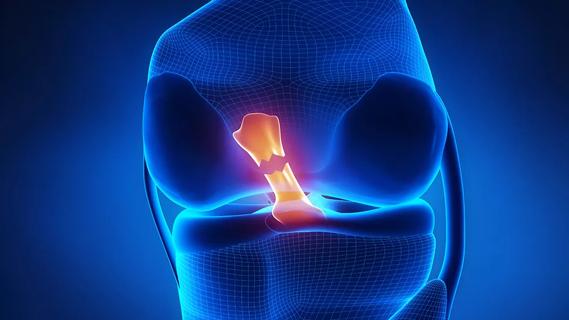
Study reports zero infections in nearly 300 patients
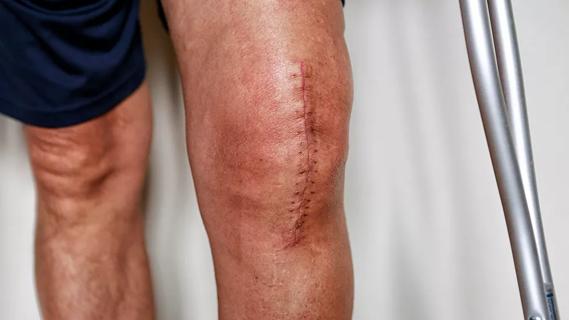
How to diagnose and treat crystalline arthropathy after knee replacement
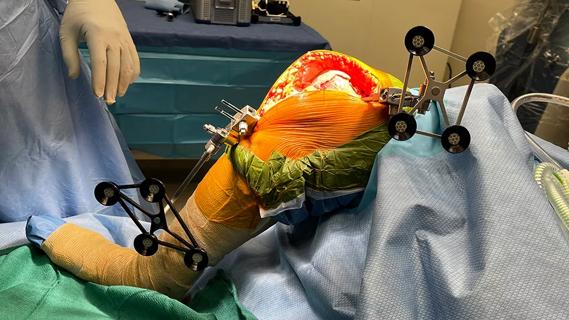
Study finds that fracture and infection are rare

Reduced narcotic use is the latest on the list of robotic surgery advantages

Cleveland Clinic orthopaedic surgeons share their best tips, most challenging cases and biggest misperceptions

How it actually compares to posterior and lateral approaches